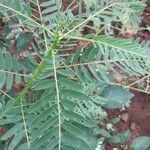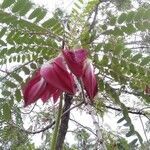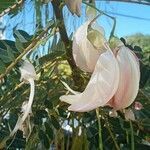Trees, 4-10 m tall, d.b.h. to 25 cm. Branches terete, leaf scars and stipule scars conspicuous. Stipules obliquely lanceolate, to 8 mm, caducous. Leaves 20-40 cm, 20-60-foliolate; rachis terete, densely appressed pubescent when young, glabrescent; petiolules 1-2 mm; stipels acerose; leaflet blades oblong, 2-5 × 0.8-1.6 cm, smaller at both ends of rachis than in middle, both surfaces with or without dense appressed purplish brown glands and appressed villous but glabrescent, secondary veins 7 or 8 on each side of midvein but inconspicuous, base rounded to broadly cuneate, apex obtuse to retuse and with a mucro. Racemes 4-7 cm, pendulous, 2-4-flowered; bract and bracteoles ovate to ovate-lanceolate, 7-10 mm, caducous, both surfaces appressed pubescent. Flowers 7-10 cm, conspicuously falcately curved in bud. Pedicel 1-2 cm, densely appressed pilose. Calyx green, campanulate, 1.8-2.9 × 1.5-2 cm, sometimes with dots, often sub-bilabiate to subtruncate with adaxial 2 teeth connate, outside glabrous except for teeth apex, inside with appressed hairs. Corolla white, pink, or rosy; standard oblong-obovate to broadly ovate, 5-7.5 × 3.5-5 cm, reflexed at anthesis, callus absent, claw ca. 1.6 cm, base subcordate, apex retuse; wings falcately long ovate, asymmetric, ca. 5 × 2 cm, claw ca. 2 cm, apex obtuse; keel curved, ca. 5 cm, claw ca. 2 cm, limbs with basal abaxial edges connate, apical 1/4-1/3 free, apex obtuse. Stamens ca. 9 mm; anthers linear, 4-5 mm, dorsifixed. Pistil linear, ca. 8 cm, compressed, falcately curved, glabrous; ovary stipitate; stigma slightly turgid. Legume linear, slightly curved, nodding, 20-60 cm × 7-8 mm, ca. 8 mm thick, dehiscent, carpopodium ca. 5 cm, suture angulate at maturity, apex tapering into a 3-4 cm beak. Seeds reddish brown, ellipsoid to subreniform, ca. 6 × 3-4 mm, slightly compressed, turgid, slightly glossy; hilum rounded, retuse. Fl. and fr. Sep-Apr. 2n = 24.
More
Small tree to 8 m tall, young parts hairy, soon becoming glabrous. Leaves alternate, even pinnate with (18-)20-40(-50) narrowly elliptic to oblong leaflets; leaflets ca. 7-10 mm wide, 25-35 mm long, rounded at the tip and base; petiole ca. 1 cm long; petiolules ca. 2 mm long, the rachis to 25 cm long; stipels minute; stipules narrowly triangular, to ca. 5 mm long, apparently deciduous. Inflores-cence of 2-4 flowered axillary racemes, pedicels to 2 cm long, thin. Flowers large and showy, ca. 6-9 cm long; hypanthium ca. 10-18 mm long, not including the narrowed base, 15-18 mm wide (flattened out); teeth low to absent, the hypan-thium rim variously erose; petals white, rosy white, or red; standard ca. 50-80 mm long, 40 mm wide, claw and basal auricles ca. 15 mm long; wing petals ca. 50-80 mm long, 20 mm wide, the claw ca. 20 mm long; keel petals upcurved, ca. 60 mm long with basal auricles, claw ca. 1/2 the length of the blade; stamens with the sheath to 80-90 mm long, 3 mm wide, strongly upcurved. Fruits long and narrow, to 50 cm long, ca. 0.6-0.9 cm wide, beaked, the stipe to 4 cm long; surface more or less flat or slightly indented between the seeds, smooth, dull; margins thickened and raised above the valve surface, also slightly indented be-tween the seeds; seeds numerous.
A shrub or small tree up to 5-10 m tall. The trunk has rough bark and the branches often droop. The trunk is thick. The branches are hairy when young. The leaves are made up of 41 to 61 leaflets. These are narrow and oblong. They are 2.5-4 cm long by 0.5-1.4 cm wide. They have a sharp point at the tip. The flowers are large and white to red. The flower petals can be 5-10 cm long. They are produced as 2-4 flowers on flowering branches 2-5 cm long. It has long narrow pods with up to 30-50 small brownish seeds. The seeds with their stalk can be 2.5-4.5 cm long in pods 20-25 cm long by 7-9 mm wide.






